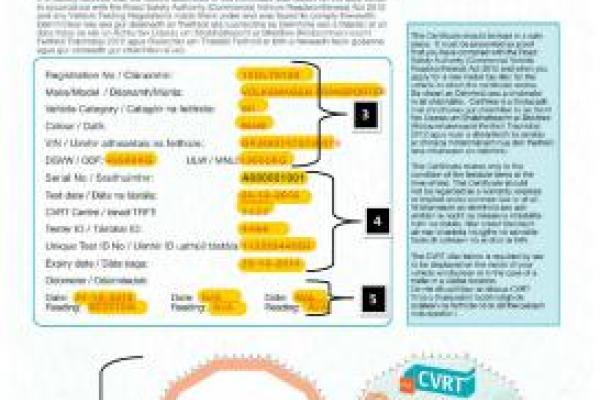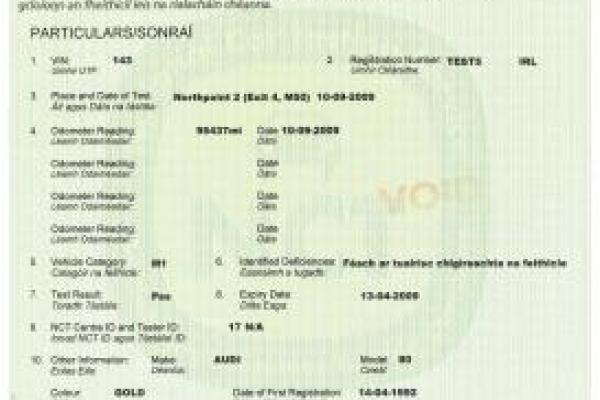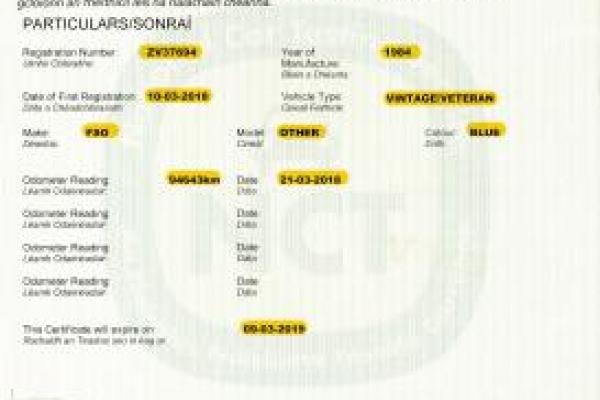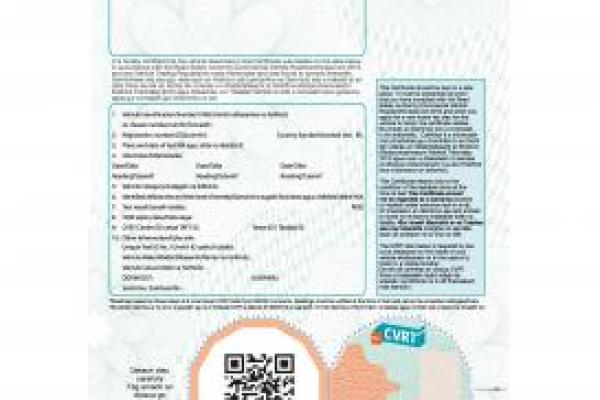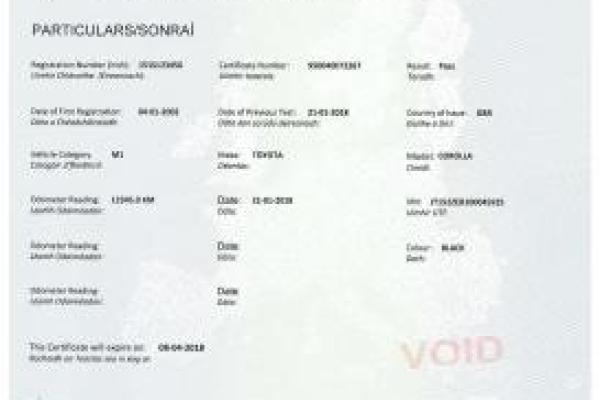General information
General overview
Ireland has two roadworthiness testing regimes, the National Car Test (NCT) and the Commercial Vehicle Test (CVRT). The NCT applies to passenger cars (M1 vehicles), while the CVRT applies to commercial vehicles, trailers and buses (N1, N2, N3, M2, M3, O3 and O4 vehicles) and tractors with a design speed of more than 40km/hr. Possible results from the NCT or CVRT regimes are:
- Pass – the vehicle has passed the test
- Minor – the vehicle has passed, with minor faults
- Major – the vehicle has failed and must return to the centre for re-inspection within 30 days
- Dangerous – the vehicle has failed due to defects that constitute a direct or immediate risk to road safety. The vehicle must not be used on the road under any circumstances.
The proof of test is a disc attached to the bottom right corner of the roadworthiness certificates. This must be torn off and displayed on the vehicle. Motorcycles and light trailers (L, O1 and O2 vehicles) are not subject to periodic roadworthiness testing. As of 20/05/2018, recognition certificates are issued for vehicles imported with a valid certificate of roadworthiness from another EU Member State. This certificate is for the unexpired portion of the non-Irish certificate of roadworthiness. If a Category M1 vehicle transfers from the small public service vehicle (SPSV) category to the private vehicle category, its next NCT test due date aligns with the expiry date of the last NCT certificate issued for this vehicle.
Test frequency
|
Categories of Vehicles (or description) |
First mandatory test |
Subsequent tests (frequency |
|
M1 |
Within four years of the date of first registration |
Every two years then every year after 10 years after the date of first registration |
|
M1 over 30 years old classified as vehicles of historical interest |
|
Every two years until 40 years after the date of first registration |
|
N1, N2, N3, M2, M3, O3 & O4 |
Within a year of the date of first registration |
Every year |
|
N1, N2, N3, M2, M3, O3 & O4 |
|
Every two years until 40 years after the date of first registration |
|
T5 fast tractors used for commercial purposes |
Within four years of the date of first registration. |
Every two years |
|
Motor caravans |
Within four years of the date of first registration |
Every two years then every year after 10 years after the date of first registration |
Exemptions:
Vehicles over 40 years old; vehicles used exclusively on islands not connected to the mainland by road; vehicles belonging to the armed forces, the Garda Síochána or the fire service.
Tractors used for the purposes of agricultural, horticultural, forestry, farming or fishery activity within the State and mainly on the land where such activity takes place, including agricultural roads, forestry roads or agricultural fields.
Responsible authorities
The Road Safety Authority (RSA) is the competent testing authority for Ireland. For passenger cars (Category M1 vehicles), roadworthiness tests are outsourced to a private operator which runs the NCT service. Test centres issue the roadworthiness certificates. For commercial vehicles (Category N1, N2, N3, M2, M3, O3, O4 and fast tractors), tests are carried out at an independent network of CVRT test centres authorised by the RSA. If vehicles pass the roadworthiness test, the CVRT centre issues a pass statement for the vehicle. The Driver Vehicle & Computer Services Division of the Dept. of Transport, Tourism and Sport then automatically issues the roadworthiness certificate from a central location.
Websites
https://www.ncts.ie/ (possible to check validity of a test) (Irish and English)
https://www.cvrt.ie/ (possible to check validity of a test) (Irish and English)
Major changes
As of 20/05/2018, a number of changes to periodic vehicle inspection have come into force to harmonise vehicle inspection across the EU.

